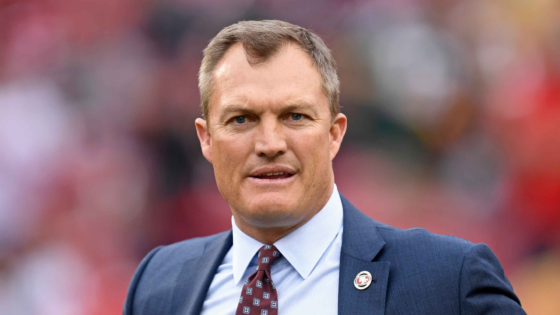There’s a lot to learn from the Philadelphia Eagles to become successful in the NFL besides Tush-Push. While some teams panic when the salary cap tightens, Howie Roseman and the Eagles treat it like a puzzle they have already solved. Their move? Covert big salaries into signing bonuses and stretch those costs over fake “void years.” It’s cap math magic. The player gets paid now, but the hit gets spread over time. Simple idea. Brutal advantage. Most teams are still catching up.
But Philly’s front office walks around like they’ve got a back belt in loopholes. Jalen Hurts? His six-year, $255 million deal didn’t gut the cap thanks to bonus tricks and some calendar gymnastics. A.J. Brown got paid, and somehow so did the Eagles. They’ve made it normal to backload payments so heavily that even the year 2029 is holding receipts. Take Mekhi Becton, for instance.
The 26-year-old guard signed a one-year, $5.5 million contract last year, but counted just $2 million on the Eagles’ cap in 2024, the only year he played in Philly. Now, he’s suiting up for the Chargers this year, yet Philly still owes him money next season in dead money. Around $3.5 million. That’s not a typo—that’s their system. It’s Howie Roseman’s system. And now? Other GMs are looking at that blueprint like it’s the Rosetta Stone.
We’re talking about John Lynch and the 49ers. The Niners had kind of a roster shuffle this year, as they’re supposed to tackle big contract extensions of Brock Purdy and George Kittle, which they eventually did. But the thing that might be overlooked is how well Lynch managed to tackle the big contract extensions with $40 million still remaining in cap space, 4th in the NFL. But how?
Well, the same way the Eagles do. John Lynch and the Niners first re-signed Kittle on a massive four-year, $76.4 million contract extension with $40 million guaranteed. While on paper, the tight end is through 2029, but he has cap impacts deferred through 2033. Courtesy? Void years. Despite averaging a bit over $19 million a year, Kittle’s cap hit for the 49ers is approximately $14.2 million, reduced from the previous $22 million.
Purdy, on the other hand, has been one of the hottest names in this offseason when it comes to the contract extensions. The quarterback signed a five-year, $265 million deal, and averages $53 million annually. The kicker? Well, Purdy’s contract counts only $9.1 million against the 2025 cap. Same thing with Fred Warner as well, who signed a three-year, $63 million contract extension.
But when we talk about his salary cap hit for the 2025 season, it just counts $16.1 million, a significant drop from the previous $28 million. That’s how John Lynch pulled off a smart “Howie Roseman” move in the 2025 NFL offseason. He pulled off three major contract extensions—and still kept the 49ers’ cap space hovering around $40 million. Again, a smart move. Brutal advantage. It’ll be pretty exciting to see how the other teams will catch up to this system.
How does “void years” help the NFL teams manage cap space?
The real difference between the Eagles and everyone else? Their owner is actually willing to put up real cash. While other teams hesitate, Philly converts base salaries into signing bonuses, spreading cap hits over future years like confetti. But that only works if your owner is cool with writing big checks upfront. Spoiler: most aren’t. Like Mike Brown of the Cincinnati Bengals.
Earlier this year, the Bengals’ quarterback, Joe Burrow, sat down on the podcast “Pardon My Take,” where he talked about the Eagles’ willingness to pay their players. “You could convert some of the money to a signing bonus, which will lower the cap hit,” Burrow said. “You can push some of the money to the back end of the contract. That lowers the cap hit.
“And then when you get to the back end of the contract, you can restructure it and convert it to a signing bonus. You can also just take less money.” Understandable, given that the Bengals just signed Tee Higgins and Ja’Marr Chase on massive contract extensions. But the Cowboys‘ co-owner, Stephen Jones, had a more cautious take on this. Jones pointed out that “I know everybody has their different battles with the cap that hit at different times. Philly will have theirs coming up, where they’ll have to make tough decisions.”
That’s the difference. The Eagles prioritize building a competitive roster, even if it means pushing money into future years. The Cowboys, on the other hand, play it safer, more focused on keeping their cap sheet clean than stacking up elite talent today. The result?
The Eagles have just won a Super Bowl, while the Cowboys have been struggling for glory for three decades now. Plus, the Eagles’ players like Jalen Hurts have $21 million against the cap, with A.J. Brown and Lane Johnson having $17 million. The Cowboys, on the other hand, have Dak Prescott and CeeDee Lamb with massive cap hits. The difference is clear.
Converting base salaries into bonuses indeed helps the teams to build a strong roster. While Stephen Jones’ point is understandable, and the Eagles are on the verge of a risk of facing a mountain of dead cap, considering the cap space is rising every year, spreading out contracts for future years won’t likely hurt much to the Eagles or John Lynch and the 49ers. At least for now.
The post 49ers GM John Lynch Exposed for Copying Eagles’ Tactic to Lock In 3 Crucial Extensions appeared first on EssentiallySports.
